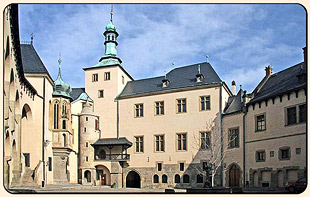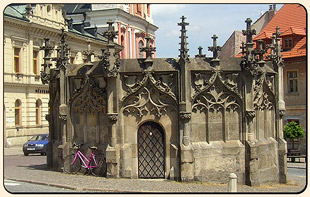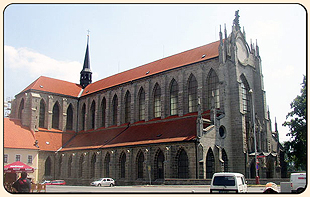
- Hradcany Quarter
- Prague Castle - The Castle Complex
- Lesser Town
- New Town
- Old Town
- Josefov - Jewish Quarter

Kutna Hora CityThe town of Kutna Hora lies 43 miles east of Prague. The historic town centre represents an architectural jewel of Europen importance. Together with the Cathedral of St. Barbara and the Church of our Lady in Sedlec, the city was added to the UNESCO List of Word Cultural Heritage. The history of Kutna Hora is closely connected with silver mining. Sometime around 1260, silver deposits were discovered on the territory of the Sedlec monastery. In the second half of the 13th century, the settlement changed very quickly into a Royal Town, competing with the capital city of Prague with its wealth in the fields of economics, politics and culture. The town became one of medieval Europe´s largest sources of silver. In the mid -16th century, the Kutna Hora mining district experienced a recession. The Osel mine, the world´s deepest at its time (at 600 meters) was shut down. Attempts to restore intensive mining activity were undertaken in the following centuries, but without success. In 1991, the last mine was closed down. Nevertheless, architectural monuments, medieval streets with many shops and galleries and a historic centre, with a peaceful atmosphere, have been preserved. This, and the town´s eventful history have, together, made the town an attraction drawing crowds of Czech as well as foreign visitors. The city Kutna Hora is about 70 minutes out of Prague. Our driver-guide will pick you up at the hotel in the time according to your choice. These special tour is arranged in a car or in Mercedes Vito, people carrier with special DVD equipment, for a group of 7 persons maximum. Price are set for whole groups regardless of the number of people. During this half-day tour, you will see films and get a general idea about the city Kutna Hora and the Czech Republic. Our driver-guide will be accompanying you whole trip. Your tour will start in front of the St. Barbara Cathedral, where you will explore interior and will be walking around the Jesuit College. From the terrace in front of College is a beautiful view of the city and St. James Church. You are continuing by narrow streets to the city centre. You will also have a chance admire historical centre full of beautiful Gothic, Renaissance and Baroque buildings protected by UNESCO. Maybe you will stop in Hradek Castle or Italian Court on the way. There are sights like the Stone fountain, the Plague Column and Stone House in the city centre. Your driver-guide is going to pick you up in the centre and drive you out to unique place the Ossuary in Sedlec. There is the church (chapel) which is decorated with more than 40 000 human bones arranged into a chandelier, the Schwarzenberg Coat-of-Arms and so on. After the excursion you will be taken to Prague by our car or minivan.
Italian Court (Vlasský Dvur)According to historic documents, Italian Court was established at the end of the 13th century. For centuries to follow, Italian Court was the centre of the state´s economic power. There was a royal mint and it was the seat of the sovereign during his stays in the town. St. Barbara Church
|
|||








